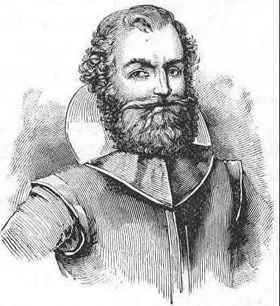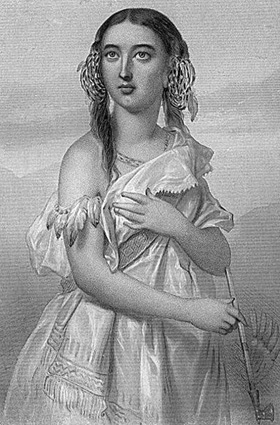The Settlement of Jamestown Colony
After you watch the video and know the material, click HERE for the quiz.
In 1607, the London Company settled the colony of Jamestown. The settlers overcame many odds to become the first permanent, English settlement in North America. In this lesson, learn about the failures and successes of Jamestown before it was taken over by the Crown.
The Virginia Company
On May 14, 1607, 104 English men and boys set foot on North American soil. They named their settlement Jamestown, in honor of the English king, James I. They got started doing what they had come to do - get rich quick by finding the gold they had all heard stories about. Jamestown had been funded by the Virginia Company, which was a joint-stock company which was a new kind of public/private partnership investing in New World colonies.
Earlier voyages had been paid for by rich businessmen or kings and queens, but joint-stock companies combined resources from both. Investors pooled their money to pay all up-front expenses of starting a colony. The government gave the company a charter with boundaries and a time limit, and in return, was granted a share of stock in the company.
Trouble in Jamestown
Jamestown had trouble from the start. The settlers had chosen their location with defense in mind. They were far enough up river to avoid the Spanish navy along the coast, on a peninsula with a deep water port and there were no Indians. But what was good for their defense was bad for their health. The tide carried in seawater they couldn't drink. The swampy peninsula was filled with mosquitoes carrying malaria. Also, many colonists suffered from dysentery and typhoid because the rivers were contaminated by their own body waste.
But it got worse. Within two weeks of their arrival, the Jamestown settlement was under attack by Virginia Indians that were part of the Powhatan Confederacy. By his own account (which most historians don't believe), Governor John Smith was kidnapped, and about to be executed when the chief's 12-year old daughter saved his life. Even if the story wasn't true, the colonists abandoned everything they were doing to build a triangular shaped fort. For years, the colonists fought with local tribes, suffering (and inflicting) murders, kidnapping, fires, thefts and more.
 |
And that still wasn't the end of their problems. Though Governor Smith had imposed a new labor law (if you don't work you don't eat), most of the colonists were gentlemen, manservants or were skilled craftsmen. Not many were accustomed to the kind of labor needed to tame a wilderness, and none of them were farmers. A few men attempted to grow crops the summer they arrived, but they were totally unsuccessful because of an unusual drought that year.
Within eight months, only 35 of the original 104 colonists were alive. Though two relief ships were sent, they didn't bring enough supplies for the people already there, let alone 140 new settlers that came on the boats. Then, in the winter of 1608, a fire destroyed a lot of their remaining supplies.
Pocahontas and Powhatan
 |
A lot of the Native Americans were hostile, but not all of them. Pocahontas, the Indian girl who supposedly saved John Smith's life, brought food to the starving colonists and intervened on their behalf several times. She was the daughter of a tribal chief named Powhatan. Powhatan offered Jamestown some protection from hostile neighbors and food in trade. But he also reminded them of his power by attacking them periodically. And two years later - when John Smith returned to England for medical treatment - Powhatan lost interest in getting along with Jamestown.
The Additional Settlers
A third relief mission failed because a hurricane drove the main supply ship aground on the uninhabited island of Bermuda. This disaster actually ended up being Jamestown's salvation a few years later - as we'll discuss in a moment.
But in the meanwhile, 80% of the settlers who came to Jamestown were dead by the winter of 1609. The desperate survivors of this starving time decided to abandon the colony. They were sailing up the James River when they were met by a ship carrying their new governor and were forced to turn back and keep trying.
It was expensive to continually resupply the colonists. The shareholders would have lost all of their investment if the settlement were abandoned, so they kept sending colonists. Between 1607 and 1622, the Virginia Company sent 10,000 people to Jamestown, only 2,000 survived.
Let's go back to the supply ship that ran aground in Bermuda. All of the people onboard survived. They built two smaller boats from the remains of their ship and sailed for Jamestown. At first their arrival just strained the settlement's resources even further. But this was the turning point in Jamestown.
Tobacco saves Jamestown
One of the Bermuda survivors, a man named John Rolfe, brought with him seeds for a type of sweet Spanish tobacco. How he got them is unclear, because those seeds were guarded to the death by the Spanish empire. However, Virginia's climate was perfect for growing tobacco. A year later when Rolfe exported his first crop to England, he became a wealthy man. Sweet Spanish tobacco was in great demand on the London market, and within a few years, Jamestown was booming from this so-called brown gold. In 1614, John Rolfe also improved the colony's chances of survival by marrying Pocahontas.
Tobacco is a very labor-intensive crop to grow - and as I've said - most of the people who went to Jamestown died, so there was a huge labor shortage. The London Company solved this problem for a little while with the brilliant solution called the headright. An investor could sponsor a worker to go to Virginia and in return would get 50 acres of land. These poor workers that got sponsorships were called indentured servants. They agreed to work for a specific amount of time - often 7 years - in exchange for passage to Jamestown, room and board, and a piece of land when their service was complete. In fact, the first Africans in Jamestown were indentured servants. This labor system helped Jamestown meet its demand for labor despite its staggering death rate.
The Royal Colony of Virginia
In 1619, representatives met to set a minimum price for tobacco exports. This assembly grew into the Virginia House of Burgesses, which was the first elected government in America.
Three years later, on March 22, 1622, an attack by the Powhatan Indians killed a quarter of the population. That, together with the London Company's insolvency, led King James to revoke the company's charter and declare Jamestown to now be the royal colony of Virginia.
Lesson Summary
Let's review. In 1607, a joint-stock company known as the London Company settled Jamestown. Investors and colonists alike had hoped to get rich quick. But the settlement had serious problems:
- their location helped spread disease
- they were attacked by the Natives in the area
- the men didn't have the skills or the desire to work as hard they needed to
- a drought kept them from growing food easily
- they had insufficient supplies, but the London Company kept sending more people
Even Though an Indian chief named Powhatan, and his daughter Pocahontas, provided some help, within a year and a half, 4 out of 5 settlers were dead. The survivors of this starving time tried to abandon the colony in 1609 but were intercepted by a supply fleet that forced them back.
When castaways from a shipwrecked supply boat showed up later that year, the colony didn't know that they had been saved. One of the new arrivals, John Rolfe, brought seeds for sweet Spanish tobacco, which grew perfectly in Virginia. The tobacco boom caused a labor shortage, but this was supplied in the form of indentured servants by investors. Citing the London Company's inability to properly manage the colony, King James revoked the Company's charter in 1622 and declared Jamestown to be the royal colony of Virginia.